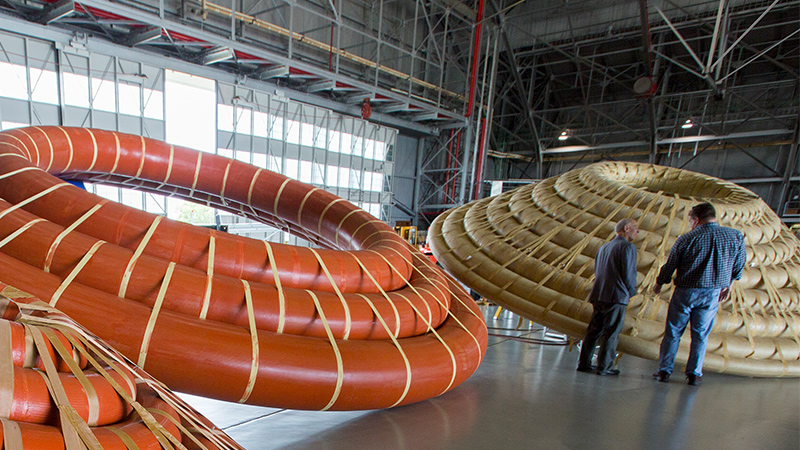Stay Up to Date
Submit your email address to receive the latest industry and Aerospace America news.
Engineers at NASA’s Langley Research Center in Virginia are completing pressure tests on a prototype inflatable spacecraft shield in preparation for a requirements review coming up in April, one of several reviews on the way to a planned atmospheric entry test from low Earth orbit in 2021.
NASA has been working since 2005 on the Hypersonic Inflatable Aerodynamic Decelerator, or HIAD, concept. Tubes of fabric would inflate in space, pulling a heat shield of silicon carbide fabric in front of them to protect a spacecraft from the heat and pressure of hypersonic entry. Shifting away from hard aeroshells could add the option of plowing through a thin atmosphere with larger-diameter spacecraft like those required for a human mission to Mars. Astronauts or rovers also could dare to land at higher elevations on Mars, such as the southern highlands that NASA theorizes were once partially above sea level when the red planet had an ocean.
“This is the technology a lot of people are waiting on,” says Neil Cheatwood, the principal investigator for the HIAD at Langley.
Despite the interest in Mars, he says the “most likely near-term candidate for actually using this would be bringing something back from low Earth orbit.”
Cheatwood says he’s coordinating with United Launch Alliance about the possibility of recovering rocket boosters by protecting them with HIADs.
NASA’s Space Technology Mission Directorate in October gave Langley the initial funding to prepare for the 2021 orbital demonstration. Next comes the April systems requirements review by NASA managers independent of the project who will study its initial design.
Engineers launched an earlier version of HIAD in 2012 and released it from the rocket at an altitude of 450 kilometers. It landed in the Atlantic Ocean as planned. The NASA team plans for the aeroshell in the 2021 demonstration to be five times heavier than its predecessor. The engineers will separate that aeroshell from the rocket at a higher altitude than the 2012 flight, testing its ability to withstand the more intense heat and pressure of a faster re-entry speed.
Pressure tests of the latest design were underway in February at Airborne Systems in Santa Ana, California. Engineers pumped compressed water into the doughnutlike tubes while they were submerged in a pool of water to test how much pressure they could withstand.
“We will test it at several times the pressure we intend to operate at,” Cheatwood says of the hydro-static tests. Engineers stress tested the heat shield in August at a supersonic wind tunnel at a Boeing lab in St. Louis. They blasted sections of shield with superheated plasma gas at Mach 4.
“The higher levels we can test these materials at, the less of those materials we need,” Cheatwood says.
Editor’s note: The NASA photo at the top of this page shows models of the Hypersonic Inflatable Aerodynamic Decelerator, or HIAD.
About Tom Risen
As our staff reporter from 2017-2018, Tom covered breaking news and wrote features. He has reported for U.S. News & World Report, Slate and Atlantic Media.
Related Posts
Stay Up to Date
Submit your email address to receive the latest industry and Aerospace America news.




